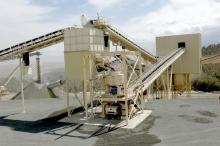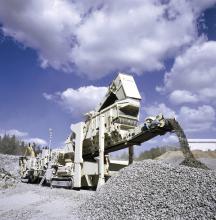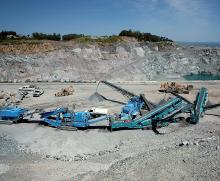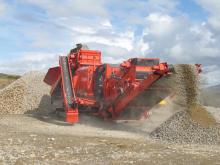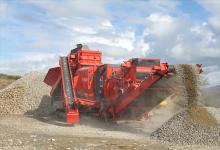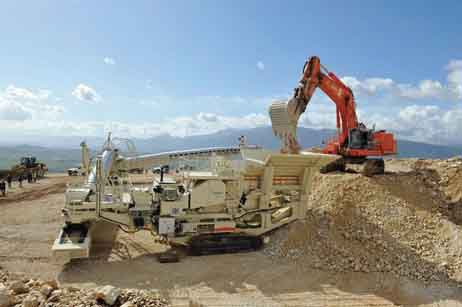
With mobile equipment becoming more and more sophisticated and increasingly capable of processing aggregates in large volumes, there has been a definite shift to the use of bigger and bigger pieces of mobile machinery. How is the industry adapting to mobile, semi-mobile or portable plants? As markets change and mature, sometimes the products that are required no longer match the output that fixed plants were designed to deliver. Equally in an uncertain and increasingly volatile global economy where volume demand moves by the day, what sort of equipment should you be looking at? Xavier Therin examines this key aggregates sector trend.
Over several years portable crushing and screening plants have become more frequently used. Through continued improvements in design, mobile crushing and screening has now become a preferred solution in many quarry applications. With the ability to be set up quickly and the flexibility to move around a site or to other sites, mobile plants can be used economically on a wide range of products, quarries and demolition sites. Designed and developed for these reasons, it is common to find mobile systems with up to three crushing stages for the production of high-quality concrete and asphalt products.
Primary crushing
Mobile or semi-mobile primary crushers have been used for a considerable time in many quarries, feeding fixed plants. They promote the utilisation of belt conveyor transport, eliminating or significantly reducing truck haulage and road construction requirements, while also, crucially, reducing investment and operating costs.
Processing plants
Mobile or semi-mobile processing plants have the advantage of being easy to set up, require little civil engineering preparation, relatively lower capital investment requirements and can easily be moved. The fact that they can be easily moved either around a site or from site to site is their key feature. This provides a remarkable amount of flexibility with regards to site optimisation. This permits numerous sites to be operated by a single plant, where traditionally each site would have had its fixed plant. This decreases overall capital costs and consequently increases return on capital investment. However, this is dependent on having numerous sites in close proximity.
In North America the plants tend to be wheel-mounted units. It is not uncommon to encounter mobile plants with a capacity of 0.8 to 1million tonnes/year. They are powered electrically, either by line power or central generators and have central a control room. These plants with primary, secondary, and tertiary crushers coupled with multiple screens, stackers and conveyor belts can take between 10-15 trucks to transport and up to two weeks to set up depending on the configuration.
In Europe, mobile plants have tended to be smaller, 0.2-0.8 million tonnes/year, and are generally tracked mounted self-contained units: self-contained primary and secondary crushers and a single screening unit, that can be transported by three to five trucks and can be set up in a few days and, consequently, be transported greater distances. These have traditionally in the past been used by contractors but more and more site operators are moving over to this type of operation.
There exists some fundamental difference between the North American market and the European markets. In North America the geographical size of the countries and the average size of the quarries are significantly greater than Europe. In addition, the average permitted road load size is also greater in North America than in Europe. Historically the North American market has tended to develop the larger wheeled plant type model; whereas in Europe the selfcontained track-mounted model has become the norm. However, in Europe, due to economies of scale and stricter permitting regulations, it would appear that there is an appetite to consolidate quarry operations. Consequently, it can be envisaged that larger portable plants will become more common in Europe.
In emerging markets, the trend will probably be a mixture of the two. This will be linked to the quality of available infrastructure. Many countries will have very basic infrastructure, which makes the transport of large loads difficult. Consequently, smaller portable plants will be preferred. However, as the markets develop and the infrastructure improves, the use of larger plants will become possible. Other factors influencing the size of plants chosen in these countries will be the product requirements. Currently the product mix in most emerging markets is quite straightforward, requiring three to five products. However, as the markets become more sophisticated a greater range of products will be demanded, requiring more complex and larger plants.
Asset optimisation
The trend towards mobile or semi-mobile plants is gaining pace. A company is able to reallocate its assets where they are most required.
In the case of multinational companies these assets can be transferred across borders (although local standards need to be taken into consideration), reflecting the variations in the global economy. Companies can optimise their assets by rotating them in the various markets. In addition, depending on the market demands for certain products, it is relatively simple to introduce a new crushing or screen module into the system. Therefore a site can easily adapt to the changes in the market product requirements.
Generally for this type of operation to be successful, no more than three moves are undertaken annually. This is because there is cost associated with the transport and the cost with the set up. Furthermore, there is the cost involved with the loss of production during the time to transport and set up. The cost resulting from too many moves would offset the benefit of having a movable plant. The maximum distance when moving is a balance between the transport cost and production time lost. The longer the distance the greater the transport costs.
Ancillary issues
The maximum permissible load on the local roads should not be underestimated. This can vary quite dramatically from country to country. This will affect the size of plants that can be easily and practically transported. In Europe traditionally, these mobile plants have been powered by diesel engines. Each unit is powered individually. This is an advantage in that they can be moved easily, but can also be a disadvantage, due to the cost of fuel. Suppliers are now offering electrically-powered alternatives.
The larger plants, as operated in North America, are electrically operated albeit often running from a single diesel generator.
Another critical issue which should not be overlooked is the availability of a mobile workforce required to operate these plants. These plants operate in campaigns and spend 3-4 months in various locations. Consequently, this means that the personnel also have to be mobile. They will spend most of their time working away from home.
This means there are additional costs associated with lodging, travel etc. Depending on the location of the operation, this can quickly become a major cost.
In many locations, especially near built-up or residential areas, noise can be a important issue. This can be a major drawback with mobile plants as it is difficult to reduce the noise levels, especially that of the diesel engines. However, companies are now focusing on this issue and are now making significant progress in soundproofing their new models to reduce overall noise levels.
Conclusion
Mobile crushing and screen plants once generally favoured by contractors are now gaining favour with quarry operators. With this type of equipment quarry operators have seen that they can optimise the utilisation of their assets, and can respond more effectively to market fluctuations. Although there are limitations to their application, it is anticipated that their use will continue to increase to the detriment of more classic fixed plants. Further development of the use of this type of equipment can be expected as the major companies such as
Xavier Therin A Chartered Mining Engineer and a member of the Institute of Materials, Minerals and Mining, with over 25 years’ experience in the metals and minerals industry. He has exercised numerous corporate, project and production management roles. In 2016 he co-founded AR5, with its staff of seasoned professionals offering management, performance and technical support assistance to the minerals industry. In 2000 he joined Lafarge, occupying between 2000 and 2016 numerous positions in the cement and aggregates product lines. His last position before co-founding AR5 was that of Group Aggregate Vice President, Land, Mineral Resources and Mining. Directing, coordinating, and formulating investment and operational policies for the group’s worldwide aggregate mining activities, encompassing over 350 quarries and 4 underground mines. As part of this role, he was responsible for the coordination of the group’s heavy mobile equipment fleet. Prior to 2000 he occupied numerous operational positions in the metal mining industry, principally in underground base metal and gold mines in Africa.

